
Order strawberries in a deluxe Parisian restaurant and you’re likely to be served berries that are very small, very expensive, and also very delicious. Such fruits are not merely scaled-down or poorly grown versions of regular strawberries, but a completely different species—the near-wild alpine strawberry, Fragaria vesca.
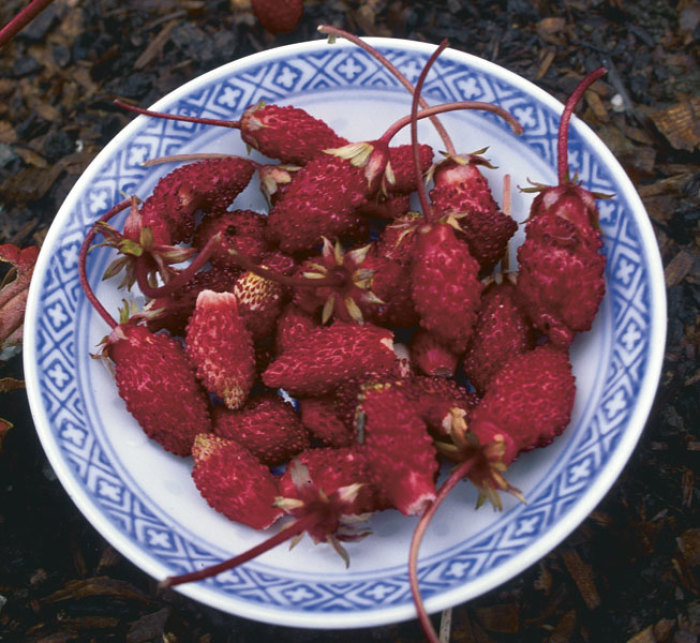 |
|
| Alpine strawberries (Fraises des bois) are prized for their sweet and delicate flavor. | |
These berries are expensive not because they are hard to grow, but because the plants are not very productive. Unlike modern strawberries, which generally produce a lot of fruit at once, alpine strawberries ripen only a few at a time. Each ripe fruit has a delectably intense, wild strawberry flavor. So, in our own back yards, where flavor is just as important as productivity, alpine strawberries are a delightful addition to the garden.
For centuries, Europeans planted alpine strawberries in their gardens in addition to harvesting them from the wild. But gardeners pretty much stopped growing them a couple of centuries ago, when the modern strawberry, a large-fruited and prolific hybrid of two American species, came on the scene.
Choose fruit that’s ruby red or creamy white
The alpine strawberry is a botanical form of the wood strawberry, often referred to by the French term, fraise des bois. These dainty plants grow wild along the edges of woods in Europe, North and South America, and northern Asia and Africa. The wood strawberry is the wild strawberry of antiquity. Mentioned in the writings of Virgil, Ovid, and Pliny, it is the strawberry that garlanded medieval paintings. The alpine form of the wood strawberry was discovered about 300 years ago east of Grenoble in the low Alps. It soon surpassed other wood strawberries in popularity. Alpine strawberry fruits are generally larger than wood strawberry fruits. And while most wood strawberries bear fruit only in spring, alpine strawberries fruit continuously throughout the growing season. Also, most strains of alpine strawberries do not send out runners, those horizontal stems that cause strawberries to spread all over the ground.
The first runnerless alpine, selected in 1811, was called ‘Bush Alpine’ or ‘Gaillon’. Other varieties soon followed. I have grown most of the red-fruited strains offered by American nurseries, including ‘Baron Solemacher’, ‘Alexandria’, ‘Mignonette’, ‘Rugen’, and ‘Charles V’, and have found no dramatic differences among them in flavor or yield. With good soil and adequate water, all bear tasty, though small, berries continuously from June to October.
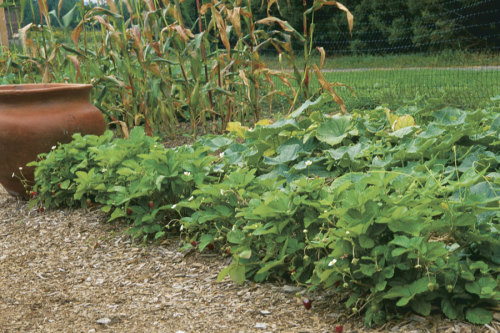 |
||
| Attractive foliage, pretty flowers, and neat growth habit make alpine strawberries good edging plants in the kitchen garden. | ||
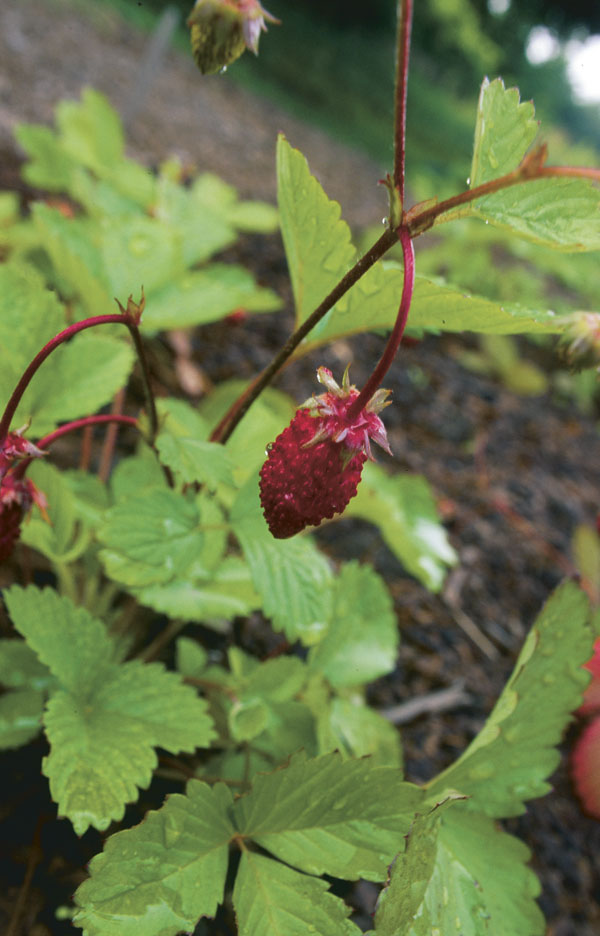 |
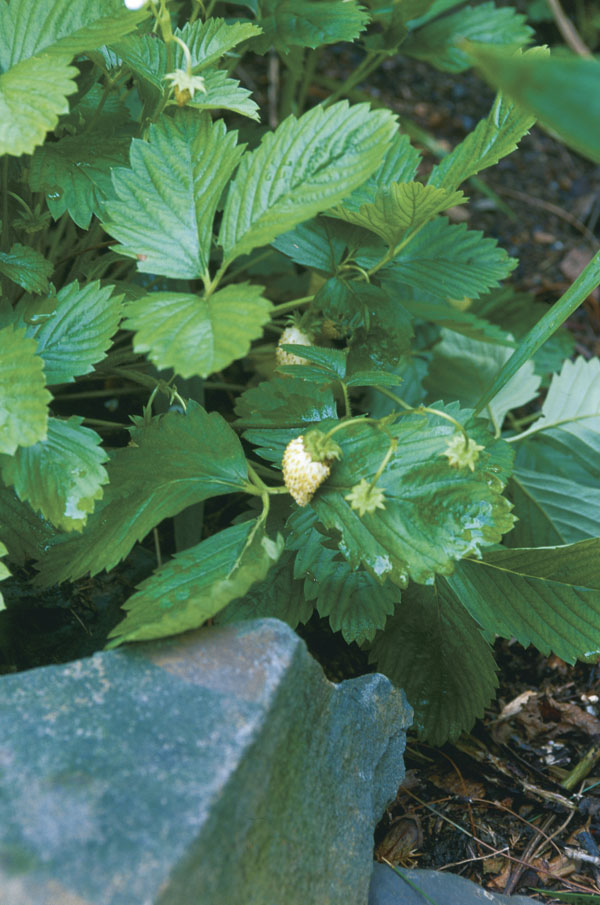 |
|
| When fully ripe, one tiny berry will perfume the air all around the plant. | White alpine strawberries have a hint of pineapple. | |
Some strains of alpine strawberries produce fruits colored creamy-white or yellow. These white varieties include ‘Bush White’, ‘Pineapple Crush’, ‘Alpine Yellow’, and ‘Alpine White’. This last variety is one that does produce runners. ‘Pineapple Crush’ fruits have a hint of pineapple flavor melded with the alpine strawberry flavor, though I do admit to the power of suggestion from the name and color of the fruits. Come to think of it, ‘Alpine Yellow’ also seems to have that hint of pineapple. Whether or not there are differences among the various white strains, I prefer them to the red strains, because the white fruits are larger and they’re ignored by birds. And real or imagined, I like that hint of pineapple.
Alpine strawberries are easygoing plants
These generally trouble-free perennials are hardy from Zones 3 to 10, where they will fruit with as little as four hours of sun a day. Alpine strawberries are not fussy and will survive in most garden soils, but they bear the most and best-tasting fruits in soils that are well-aerated, moisture retentive, and rich in organic matter. Assuming a site above the water table, the best means to ensure fertility, aeration, and water retention in soil is to add plenty of organic matter, such as compost or well-rotted manure.
Like regular garden strawberries, alpine strawberries have shallow roots, susceptible to the effects of the hot summer sun, careless hoes and tillers, drought, and competition from weeds. To avert all these potential problems at once, I mulch my plants with compost, pine needles, or straw. Organic mulches continually enrich the soil as they decompose, so they need annual replenishment. I generally add fresh mulch in spring to discourage weeds and keep soil cool during the hot summer months.
Unlike hybrid strawberries, alpine strawberries come “true” from seed, so they can be propagated reliably this way. Grow them from seed just like tomatoes. In late winter or early spring, sprinkle the tiny seeds evenly over a flat filled with a well-drained potting mix. Just barely cover the seed, then water from below by setting the flat in a pan of water. The seeds will not germinate all at once, so don’t disturb the seedlings for a few weeks after the first ones emerge. After about a month of growth, the seedlings should be sturdy enough to be replanted into individual pots or plastic flats.
Young alpine strawberry seedlings are cold tender, so harden them off carefully, and transplant into the garden after all chance of spring frost has passed. Seedlings planted in spring should begin ripening their first berries that same summer. In years to follow, the plants will begin fruiting in spring. Young alpine strawberry plants are also available by mail, or if you’re lucky, at a good local garden center. Set out in spring, these plants will begin to bear fruit in early summer.
Crown division is another way to propagate new plants from an established plant. As with most herbaceous perennials, division rejuvenates old plants. To divide a plant, dig it up in early spring, and cut off young sprigs with some attached roots from around the outside of the clump. Replant the sprigs and toss the old center of the plant into your compost pile.
Alpine strawberry plants can produce fruit whenever temperatures are warm, although they do slow down in really hot weather. With a sunny window or a greenhouse, the harvest season can be extended even further into the fall or advanced in the spring.
I’ve reaped an early spring harvest from alpine strawberry plants growing in 6-inch flower pots set on a sunny windowsill. Indoors, potted plants need no special treatment except plenty of light in winter and an occasional dab of their flowers with a small paintbrush to ensure pollination.
Though these tough little plants are subject to many of the same pests as regular strawberries, problems rarely develop given good garden culture. Growing alpine strawberries in a site with good air circulation and well-drained soil and providing them with sufficient water will prevent most pests from causing serious damage. It’s wise to remove diseased plants or plant parts promptly to eliminate the risk of all plants becoming afflicted. Keep an eye out for whiteflies on indoor plants.
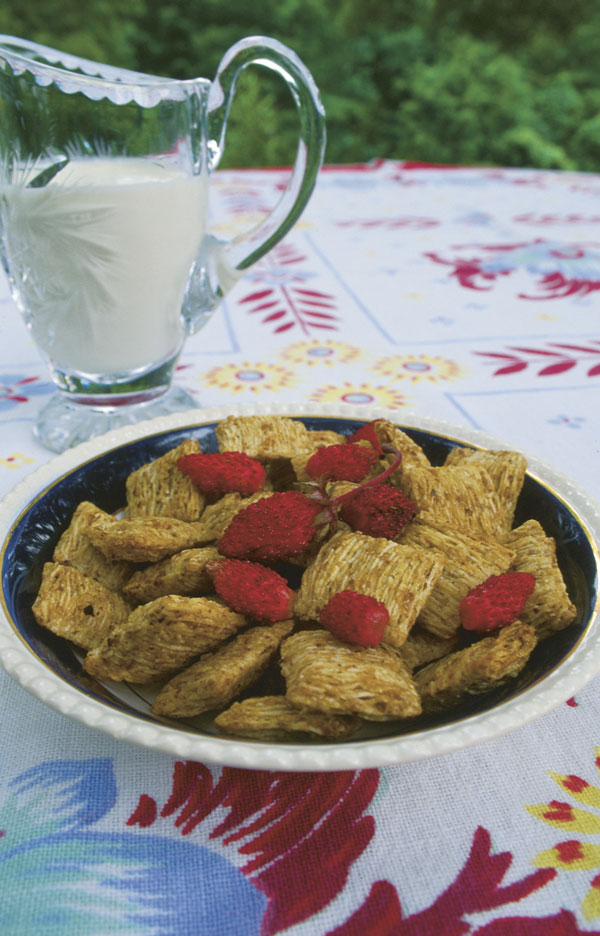 |
|
| Eat alpine strawberries out of hand or serve them simply—scattered on a bowl of cereal, with plain pound cake, or floating in a glass of champagne. | |
Grow them for the flavor
I wouldn’t suggest planting alpine strawberries instead of regular ones, for the bed would never produce enough fruit to stock a freezer. True, the French King Charles V had 1,200 wood strawberry plants set in the Louvre garden in 1368, but he had no choice—the modern strawberry had not yet been created.
Alpine strawberries, nonetheless, do have a place in today’s gardens. The plants are very ornamental. They form attractive green mounds with white blossoms staring out above the foliage from atop thin flower stalks. The neat, compact habit of non-running alpine strawberries makes them ideal for edgings. I have planted them 6 inches apart to make a tiny hedge in the flower border along my terrace. They also make attractive specimen plants in pots.
The best reason to grow alpine strawberries is, of course, their flavor. But be forewarned: The fruits taste like cotton until dead ripe. When they are ready for harvest, the fruits become so aromatic a single ripe berry perfumes the air all around the plant. It’s a fragrance that rivals the most intoxicating of flowers. At this stage the fruit is so soft it almost crushes when picked, yet another reason alpine strawberries are unsuitable for large-scale commercial cultivation. In my back yard, though, the ripe fruits never travel further than arm’s length.
| Sources for alpine strawberry plants and seeds | |
| Raintree Nursery 391 Butts Road Morton, WA 98536 360-496-6400 www.raintreenursery.com plantsRenee’s Garden 6116 Highway 9 Felton, CA 95018 888-880-7228 www.reneesgarden.com seeds |
Johnny’s Selected Seeds 955 Benton Avenue Winslow, Maine 04901 877-564-6697 www.johnnyseeds.com seedsTerritorial Seed Company PO Box 158 Cottage Grove, OR 97424 800-626-0866 www.territorialseed.com seeds |
Lee Reich grows a wide variety of fruits in New Paltz, New York, and is the author of Uncommon Fruits Worthy of Attention and The Pruning Book.
February 1999
from Kitchen Gardener, issue #19



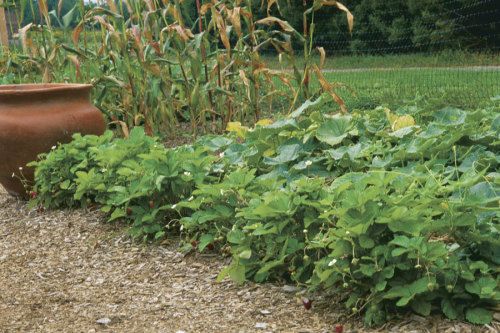
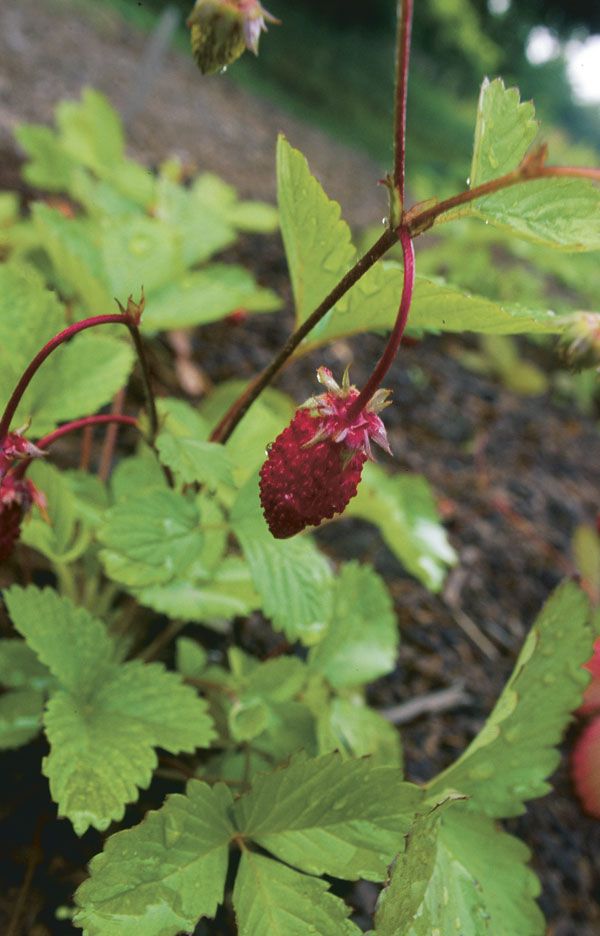
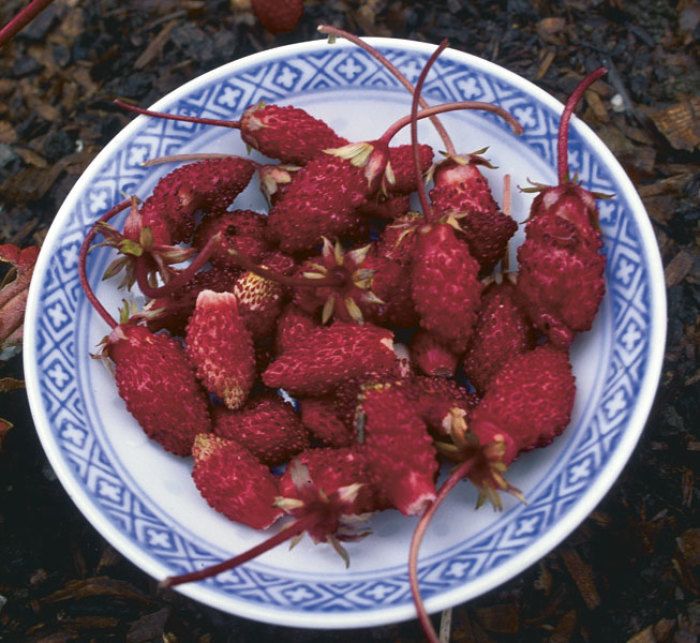
















Comments
Like to read the great article here must be thanks for this post you can need to seen the file explorer windows 10 here it is the batter way to access the all file and folder easily so save setting here.
Log in or create an account to post a comment.
Sign up Log in